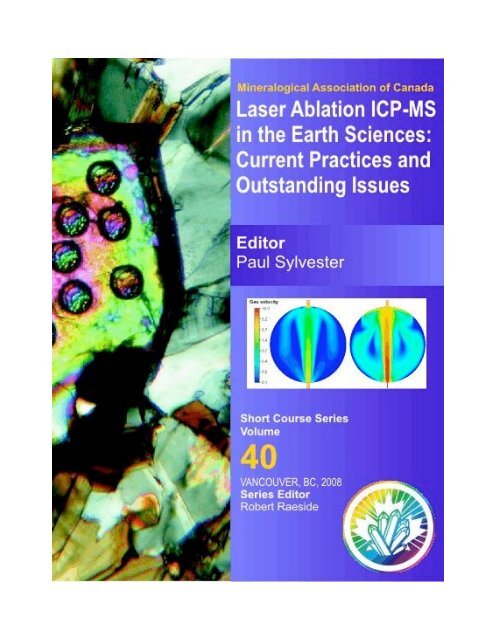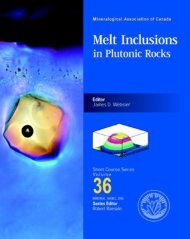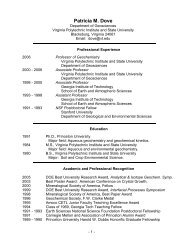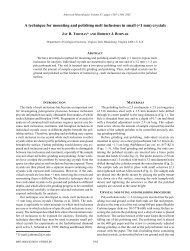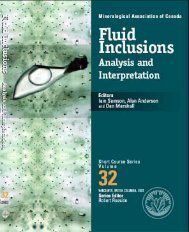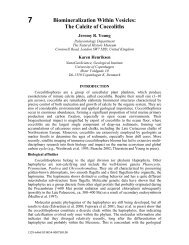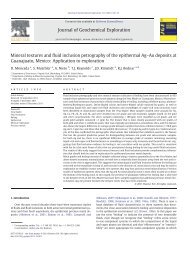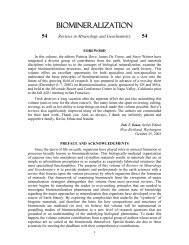Laser Ablation–ICP–MS in the Earth Sciences ... - Virginia Tech
Laser Ablation–ICP–MS in the Earth Sciences ... - Virginia Tech
Laser Ablation–ICP–MS in the Earth Sciences ... - Virginia Tech
Create successful ePaper yourself
Turn your PDF publications into a flip-book with our unique Google optimized e-Paper software.
<strong>Laser</strong> <strong>Ablation–ICP–MS</strong> <strong>in</strong> <strong>the</strong> <strong>Earth</strong> <strong>Sciences</strong><br />
CURRENT PRACTICES AND OUTSTANDING ISSUES<br />
M<strong>in</strong>eralogical Association of Canada<br />
Short Course Series Volume 40<br />
Edited by<br />
Paul Sylvester<br />
Department of <strong>Earth</strong> <strong>Sciences</strong>,<br />
Memorial University of Newfoundland,<br />
St. John's, Newfoundland & Labrador,<br />
A1B 3X5, Canada<br />
Short Course delivered <strong>in</strong> association with Goldschmidt 2008,<br />
Vancouver, B.C., 19–20 July, 2008.
S.R. MUTCHLER, L. FEDELE & R.J. BODNAR<br />
APPENDIX A5: ANALYSIS MANAGEMENT SYSTEM (AMS) FOR REDUCTION OF LASER<br />
ABLATION ICP–MS DATA<br />
S.R. Mutchler, L. Fedele and R.J. Bodnar<br />
Department of Geosciences<br />
Virg<strong>in</strong>ia <strong>Tech</strong><br />
Blacksburg, VA 24061<br />
E-mail: rjb@vt.edu<br />
INTRODUCTION<br />
This paper describes <strong>the</strong> Analysis Management<br />
System (AMS) software that has recently been<br />
developed to facilitate <strong>the</strong> reduction of data from<br />
laser ablation <strong>in</strong>ductively coupled plasma–mass<br />
spectrometric (LA–ICP–MS) analysis of various<br />
materials. While <strong>the</strong> AMS software is applicable to<br />
analysis of any material, it was developed to<br />
address analytical and data reduction issues that are<br />
unique to <strong>the</strong> analysis of materials that are small<br />
(result<strong>in</strong>g <strong>in</strong> a short-lived signal) and/or<br />
heterogeneous at <strong>the</strong> scale (both spatial and<br />
temporal) of <strong>the</strong> analysis. Specifically, <strong>the</strong> AMS<br />
software is designed and optimized for reduction of<br />
data from fluid and melt <strong>in</strong>clusions <strong>in</strong> geologic<br />
samples (Roedder 1984).<br />
In develop<strong>in</strong>g <strong>the</strong> AMS software, our goals<br />
were to develop an easy to use tool for reduction of<br />
LA–ICP–MS data from fluid and melt <strong>in</strong>clusions.<br />
To accomplish this we have automated many of <strong>the</strong><br />
time-consum<strong>in</strong>g steps commonly <strong>in</strong>volved <strong>in</strong> LA–<br />
ICP–MS data reduction, such as normalization to<br />
100% oxides. In addition, <strong>the</strong> AMS can provide<br />
more accurate and precise results by m<strong>in</strong>imiz<strong>in</strong>g<br />
systematic errors, by allow<strong>in</strong>g <strong>the</strong> use of multiple<br />
standards, and by <strong>in</strong>corporat<strong>in</strong>g an improved drift<br />
correction methodology.<br />
The AMS software has <strong>the</strong> option to provide<br />
output as a s<strong>in</strong>gle file that conta<strong>in</strong>s <strong>the</strong> ICP–MS<br />
data, <strong>the</strong> various options for data reduction, and <strong>the</strong><br />
results, and is thus highly transportable. Moreover,<br />
AMS is a stand-alone software package that<br />
elim<strong>in</strong>ates <strong>the</strong> need to purchase and learn to use<br />
commercial software. AMS software is written <strong>in</strong><br />
Java and runs on Unix, Mac<strong>in</strong>tosh or W<strong>in</strong>dows<br />
platforms. AMS is compatible with data formats<br />
used by most of <strong>the</strong> major ICP–MS manufacturers<br />
(e.g., Perk<strong>in</strong> Elmer, Agilent, or any o<strong>the</strong>r <strong>in</strong>strument<br />
that has CSV-formatted output). AMS outputs <strong>the</strong><br />
results <strong>in</strong> Excel, PDF, HTML or CSV formats. It is<br />
fully configurable by <strong>in</strong>dividual users and allows<br />
edit<strong>in</strong>g of XML text files to <strong>in</strong>clude, for example,<br />
M<strong>in</strong>eralogical Association of Canada Short Course 40, Vancouver, B.C., p. 318–327.<br />
318<br />
additional standards or new mass conversion values.<br />
Importantly, <strong>the</strong> software <strong>in</strong>corporates well<br />
established algorithms for data analysis (Gun<strong>the</strong>r et<br />
al. 1998, Halter et al. 2002, He<strong>in</strong>rich et al. 2003,<br />
Longerich et al. 1996).<br />
Both <strong>the</strong> software and source code are available<br />
on <strong>the</strong> Fluids Research Laboratory website at:<br />
http://www.geochem.geos.vt.edu/fluids/laICP–MS/<br />
ams.shtml. AMS software is a community project<br />
<strong>in</strong> which <strong>in</strong>terested persons can submit requests to<br />
enhance <strong>the</strong> software or report bugs. AMS software<br />
is an Open Source application under GPL.<br />
In <strong>the</strong> follow<strong>in</strong>g sections we describe those<br />
features of <strong>the</strong> AMS software that make it unique or<br />
which represent improvement over exist<strong>in</strong>g LA–<br />
ICP–MS data reduction packages. This is<br />
accomplished by describ<strong>in</strong>g features for us<strong>in</strong>g<br />
multiple standards, apply<strong>in</strong>g drift corrections,<br />
visualiz<strong>in</strong>g fractionation patterns dur<strong>in</strong>g <strong>the</strong> analysis<br />
and f<strong>in</strong>ally by provid<strong>in</strong>g work<strong>in</strong>g examples of <strong>the</strong><br />
reduction of LA–ICP–MS data from fluid and melt<br />
<strong>in</strong>clusions.<br />
USE OF MULTIPLE STANDARDS AND<br />
DRIFT CORRECTION<br />
AMS supports <strong>the</strong> use of multiple standards for<br />
a s<strong>in</strong>gle analysis. In addition, AMS supports<br />
multiple standard runs (at different times) for each<br />
standard. A typical data reduction <strong>in</strong> AMS may<br />
<strong>in</strong>clude 6 or more spectra from 2 or more standards<br />
(e.g., NIST 610, 612, etc.) that bracket (<strong>in</strong> time) <strong>the</strong><br />
actual FI or MI analysis. The uncerta<strong>in</strong>ty <strong>in</strong><br />
standard concentrations has been shown to be one<br />
of <strong>the</strong> largest sources of error <strong>in</strong> LA–ICP–MS<br />
analysis. If multiple standards (as a multi-po<strong>in</strong>t<br />
calibration) are used dur<strong>in</strong>g <strong>the</strong> analysis of a sample<br />
with “known” element concentrations, such as <strong>the</strong><br />
G-Probe-2 microprobe standard (Potts et al. 2008),<br />
<strong>the</strong> error <strong>in</strong> element abundance is commonly less<br />
than if only a s<strong>in</strong>gle standard was used (Fig. A5-1).<br />
If <strong>the</strong> FI or MI analysis is bracketed by<br />
standard runs, AMS can also correct for any
2 Standards<br />
1 Standard<br />
No Drift Correction<br />
5.5 %<br />
5.7 %<br />
ANALYSIS MANAGEMENT SYSTEM (AMS)<br />
9.2 %<br />
0 1 2 3 4 5 6 7 8 9 10<br />
Average Error - All Elements (%)<br />
FIG. A5-1. Comparison of <strong>the</strong> average error <strong>in</strong><br />
concentration (20 analyses) of 35 elements [Al, B, Ba,<br />
Ca, Ce, Cr, Cs, Cu, Eu, Fe, Gd, Hf, K, La, Mg, Mn,<br />
Na, Nb, Nd, Ni, Pb, Rb, Sc, Si, Sm, Sr, Ta, Tb, Th, Ti,<br />
U, V, Y, Zn, Zr] <strong>in</strong> <strong>the</strong> G-Probe-2 standard for data<br />
reduction <strong>in</strong>volv<strong>in</strong>g only a s<strong>in</strong>gle po<strong>in</strong>t standard with<br />
no drift correction (No Drift Correction), a s<strong>in</strong>gle<br />
standard with drift correction (1 Standard), and two<br />
standards with drift correction (2 Standards).<br />
<strong>in</strong>strumental drift (if present). AMS calculates <strong>the</strong><br />
time-dependent drift <strong>in</strong> concentration for each<br />
element by calculat<strong>in</strong>g <strong>the</strong> element concentration<br />
us<strong>in</strong>g each standard run as a s<strong>in</strong>gle po<strong>in</strong>t calibration.<br />
AMS <strong>the</strong>n does a regression of element<br />
concentration vs. <strong>the</strong> time dur<strong>in</strong>g <strong>the</strong> analytical<br />
sequence when <strong>the</strong> standard was analyzed. If <strong>the</strong><br />
correlation (R 2 ) is greater than a user-specified<br />
value, AMS uses <strong>the</strong> regression value; o<strong>the</strong>rwise<br />
AMS uses <strong>the</strong> concentration of <strong>the</strong> element<br />
calculated us<strong>in</strong>g <strong>the</strong> standard run closest <strong>in</strong> time<br />
(ei<strong>the</strong>r before or after) to <strong>the</strong> analysis time.<br />
Analysis times are <strong>in</strong>ferred from <strong>the</strong> ICP–MS data<br />
file time stamp.<br />
An example of <strong>the</strong> method used for drift correction<br />
is shown <strong>in</strong> Figure A5-2 for Rb. Sample G-Probe-2<br />
(Potts et al. 2008) was analyzed 20 times over a<br />
period of about 200 m<strong>in</strong>utes, with <strong>the</strong> NIST 610 and<br />
612 standards analyzed at <strong>the</strong> beg<strong>in</strong>n<strong>in</strong>g, near <strong>the</strong><br />
middle, and at <strong>the</strong> end of <strong>the</strong> session. Shown on <strong>the</strong><br />
Rb<br />
Concentration (ppm)<br />
36.5<br />
35.5<br />
34.5<br />
33.5<br />
32.5<br />
31.5<br />
1<br />
Drift Corrected<br />
Concentration<br />
2<br />
tanalysis<br />
NIST 610<br />
NIST 612<br />
G-probe-2<br />
550 570 590 610 630 650 670 690 710 730 750<br />
Time (m<strong>in</strong>utes after midnight)<br />
3<br />
4<br />
319<br />
diagram are six concentrations for Rb <strong>in</strong> <strong>the</strong> G-<br />
Probe-2 sample that would have been obta<strong>in</strong>ed if<br />
only a s<strong>in</strong>gle po<strong>in</strong>t calibration was used. For<br />
example, if <strong>the</strong> NIST 610 standard labeled “1” had<br />
been used as a s<strong>in</strong>gle po<strong>in</strong>t standard, <strong>the</strong><br />
concentration predicted for <strong>the</strong> unknown analyzed<br />
at time t=618 m<strong>in</strong> would have been about 36.5 ppm.<br />
Similarly, if <strong>the</strong> NIST 610 standard labeled “6” had<br />
been used to determ<strong>in</strong>e <strong>the</strong> composition of Rb <strong>in</strong> <strong>the</strong><br />
analysis conducted at 618 m<strong>in</strong>, <strong>the</strong> estimated<br />
concentration would have been about 31.5 ppm.<br />
However, by analyz<strong>in</strong>g multiple standards<br />
periodically dur<strong>in</strong>g <strong>the</strong> entire analytical session and<br />
us<strong>in</strong>g <strong>the</strong>se data to def<strong>in</strong>e a drift correction def<strong>in</strong>ed<br />
by <strong>the</strong> l<strong>in</strong>ear regression l<strong>in</strong>e through <strong>the</strong> standards<br />
data, a corrected concentration of approximately<br />
34.6 ppm is obta<strong>in</strong>ed. The results show clearly that<br />
<strong>the</strong> use of only a s<strong>in</strong>gle po<strong>in</strong>t reference standard,<br />
collected ei<strong>the</strong>r before or after <strong>the</strong> analytical<br />
session, that did not take <strong>in</strong>to account <strong>in</strong>strumental<br />
drift could lead to a less accurate result for <strong>the</strong><br />
unknown.<br />
ELEMENTAL FRACTIONATION DURING<br />
ANALYSIS<br />
Elemental fractionation can be a major issue<br />
dur<strong>in</strong>g LA−ICP–MS analyses (Gun<strong>the</strong>r &<br />
Hattendorf 2001). AMS provides a method to<br />
estimate <strong>the</strong> amount of fractionation for each<br />
element <strong>in</strong> a homogeneous sample volume through<br />
a series of fractionation plots (FP). When <strong>the</strong> option<br />
to generate <strong>the</strong> FP is on (see below), <strong>the</strong> signal<br />
region of <strong>in</strong>terest (SROI) selected by <strong>the</strong> operator is<br />
divided <strong>in</strong>to 10 slices and data reduction is<br />
performed on each slice. After <strong>the</strong> analysis <strong>the</strong><br />
results are plotted as concentration vs. time,<br />
allow<strong>in</strong>g a visual estimate of how SROI selection<br />
affects <strong>the</strong> outcomes of <strong>the</strong> calculations (Fig. A5-3).<br />
6<br />
5<br />
FIG. A5-2. Concentration of Rb<br />
<strong>in</strong> sample G-Probe-2 that<br />
would be obta<strong>in</strong>ed for <strong>the</strong><br />
analysis conducted at ≈618<br />
m<strong>in</strong> us<strong>in</strong>g six s<strong>in</strong>gle po<strong>in</strong>t<br />
standards (labeled 1 to 6),<br />
compared to <strong>the</strong> concentration<br />
that is obta<strong>in</strong>ed if <strong>the</strong><br />
six s<strong>in</strong>gle po<strong>in</strong>t standards are<br />
used to def<strong>in</strong>e an <strong>in</strong>strumental<br />
drift correction l<strong>in</strong>e.
Concentration (ppm)<br />
148<br />
146<br />
144<br />
142<br />
140<br />
138<br />
Integration Start<br />
S.R. MUTCHLER, L. FEDELE & R.J. BODNAR<br />
320<br />
Zn<br />
Integration End<br />
2 4 6 8 10 12 14 16 18 20<br />
Time (s)<br />
The ideal output (i.e., complete absence of fractionation)<br />
would be a flat l<strong>in</strong>e (∆C/∆t = 0) where <strong>the</strong><br />
concentration (C) <strong>in</strong> each of <strong>the</strong> 10 slices is <strong>the</strong><br />
same. Additional plots also display <strong>the</strong> standard/<br />
element signal ratios. The signal ratio plots show<br />
<strong>the</strong> stability (or lack <strong>the</strong>reof) of <strong>the</strong> <strong>in</strong>tensity ratios<br />
dur<strong>in</strong>g <strong>the</strong> analysis.<br />
FLUID INCLUSION ANALYSIS AND DATA<br />
REDUCTION<br />
The logical steps followed dur<strong>in</strong>g analysis of<br />
fluid and melt <strong>in</strong>clusions are shown <strong>in</strong> Figure A5-4.<br />
The analysis of fluid or melt <strong>in</strong>clusions starts with<br />
detailed petrographic exam<strong>in</strong>ation of each sample to<br />
determ<strong>in</strong>e <strong>the</strong> relationship of <strong>the</strong> <strong>in</strong>clusions to <strong>the</strong><br />
FIG. A5-3. Fractionation<br />
plot produced by<br />
AMS show<strong>in</strong>g <strong>the</strong><br />
concentration of z<strong>in</strong>c<br />
as a function of time<br />
<strong>in</strong> <strong>the</strong> signal region of<br />
<strong>in</strong>terest.<br />
host m<strong>in</strong>eral phase and to <strong>the</strong> petrogenesis of <strong>the</strong><br />
sample (Bodnar 2003, Bodnar & Student 2006)<br />
(Fig. A5-4, box 1). After <strong>the</strong> fluid <strong>in</strong>clusions have<br />
been selected, <strong>the</strong> freez<strong>in</strong>g po<strong>in</strong>t depression or <strong>the</strong><br />
halite disappearance temperature of <strong>the</strong> <strong>in</strong>clusions is<br />
determ<strong>in</strong>ed by micro<strong>the</strong>rmometry (Fig. A5-4, box<br />
2). These temperatures are entered <strong>in</strong>to AMS,<br />
which <strong>the</strong>n uses published algorithms (Bodnar<br />
1993, Bodnar et al. 1989, Sterner et al. 1988) to<br />
calculate an NaCl-equivalent bulk sal<strong>in</strong>ity of <strong>the</strong><br />
<strong>in</strong>clusion (Fig. A5-4, box 3). The bulk sal<strong>in</strong>ity of<br />
<strong>the</strong> <strong>in</strong>clusion, <strong>in</strong> conjunction with elemental<br />
concentration ratios determ<strong>in</strong>ed by LA–ICP–MS<br />
analysis, is used to calculate <strong>the</strong> absolute element<br />
concentrations <strong>in</strong> <strong>the</strong> <strong>in</strong>clusion.<br />
1 8 12 15<br />
Petrography MI MI (Host Correction) Mixed (Host + MI signal)<br />
2<br />
FI Micro<strong>the</strong>rmometry<br />
(Tm, ice :Td,halite )<br />
3<br />
Bulk Sal<strong>in</strong>ity (NaCl eq.)<br />
4<br />
LA-ICP-MS Integrated Signal<br />
5<br />
Element Ratio (K/Na, Mg/Na, etc.<br />
NaCl eq = NaCl + KCl + MgCl + ...<br />
6<br />
Drift Correction<br />
7<br />
Absolute Element Conc.<br />
9<br />
Exposed MI<br />
10<br />
LA-ICP-MS Integrated Signal<br />
11<br />
Element Ratio (Si/Ca, Na/Ca, etc. )<br />
�<br />
Element conc. recast as:<br />
Oxides<br />
Carbonates<br />
Sulfides<br />
or<br />
pure MI<br />
signal<br />
= 100 %<br />
Element Ratios + EMPA conc. of one elem.<br />
13<br />
Host Only<br />
LA-ICP-MS<br />
Integrated Signal<br />
14<br />
Host Element Conc.<br />
16<br />
Mixed LA-ICP-MS Integrated signal)<br />
17<br />
Element Ratio (Si/Ca, Na/Ca, etc. )<br />
�<br />
Element conc. recast as:<br />
Oxides<br />
= 100 %<br />
Carbonates<br />
Sulfides<br />
18<br />
Mixed Element Conc.<br />
19<br />
Known Elem. Conc.<br />
e.g. Al <strong>in</strong> Host/MI<br />
20<br />
Proportionally<br />
allocate mix<br />
concentration us<strong>in</strong>g<br />
Al conc.<br />
FIG. A5-4. Flow chart show<strong>in</strong>g <strong>the</strong> sequence of tasks <strong>in</strong>volved <strong>in</strong> <strong>the</strong> analysis and data reduction for fluid and melt <strong>in</strong>clusions<br />
us<strong>in</strong>g AMS software.
AMS uses <strong>the</strong> LA–ICP–MS signal from <strong>the</strong> FI<br />
(Fig. A5-4, box 4) and a known external standard<br />
(e.g., NIST 610) to calculate elemental concentration<br />
ratios (Fig. A5-4, box 5). AMS uses <strong>the</strong><br />
<strong>in</strong>tegrated signal areas after background subtraction<br />
for <strong>the</strong> FI and standard to determ<strong>in</strong>e elemental<br />
<strong>in</strong>tensity ratios us<strong>in</strong>g equation (1) (from (Longerich<br />
et al. 1996). The use of an external standard<br />
elim<strong>in</strong>ates <strong>the</strong> effects of element-specific <strong>in</strong>strumental<br />
sensitivity (Longerich et al. 1996).<br />
C<br />
C<br />
Sample<br />
Ca<br />
Sample<br />
Na<br />
C<br />
C<br />
S tan d<br />
Ca<br />
S tan d<br />
Na<br />
I<br />
×<br />
I<br />
Sample<br />
Ca<br />
Sample<br />
Na<br />
ANALYSIS MANAGEMENT SYSTEM (AMS)<br />
× I<br />
× I<br />
S tan d<br />
Na<br />
S tan d<br />
Ca<br />
= (1)<br />
The absolute concentrations of <strong>in</strong>dividual elements<br />
<strong>in</strong> <strong>the</strong> <strong>in</strong>clusion are determ<strong>in</strong>ed from <strong>the</strong> calculated<br />
element ratios and <strong>the</strong> bulk sal<strong>in</strong>ity obta<strong>in</strong>ed by<br />
micro<strong>the</strong>rmometry us<strong>in</strong>g mass balance constra<strong>in</strong>ts<br />
(He<strong>in</strong>rich et al. 2003) (Fig. A5-4, box 7), with or<br />
without a drift correction (Fig. A5-4, box 6).<br />
After <strong>the</strong> laser ablation ICP–MS spectra have<br />
been collected, one launches <strong>the</strong> options w<strong>in</strong>dow <strong>in</strong><br />
AMS (Fig. A5-5) to def<strong>in</strong>e <strong>the</strong> parameters used<br />
321<br />
dur<strong>in</strong>g <strong>the</strong> analysis, <strong>in</strong>clud<strong>in</strong>g which standards were<br />
used, how many standard analyses were conducted,<br />
and <strong>the</strong> method that will be used to calculate<br />
concentrations. In <strong>the</strong> example shown <strong>in</strong> Figure<br />
A5-5, four analyses of NIST 610 (two at <strong>the</strong><br />
beg<strong>in</strong>n<strong>in</strong>g of <strong>the</strong> session and two at <strong>the</strong> end) were<br />
used for <strong>the</strong> external standards. Dur<strong>in</strong>g micro<strong>the</strong>rmometry,<br />
<strong>the</strong> ice phase melted at –18ºC, and<br />
this value is entered <strong>in</strong> <strong>the</strong> “Method” section and<br />
used to calculate <strong>the</strong> bulk sal<strong>in</strong>ity. The host<br />
correction options shown <strong>in</strong> <strong>the</strong> lower left are not<br />
required for this fluid <strong>in</strong>clusion analysis because <strong>the</strong><br />
host is quartz and we did not measure Si <strong>in</strong> <strong>the</strong> FI.<br />
The <strong>in</strong>strument sett<strong>in</strong>gs used dur<strong>in</strong>g <strong>the</strong> analysis<br />
<strong>in</strong>cluded concentrations <strong>in</strong> counts, with a dwell time<br />
of 0.01 sec and drift correction confidence <strong>in</strong>terval<br />
(R 2 ) of 0.9. In this example, <strong>the</strong> “Generate<br />
fractionation plots” option was not selected. At <strong>the</strong><br />
conclusion of <strong>the</strong> data reduction process, <strong>the</strong> results<br />
w<strong>in</strong>dow (see below) will be shown and <strong>the</strong> results<br />
will be written to an Excel file, as def<strong>in</strong>ed by <strong>the</strong><br />
output options.<br />
Once all <strong>the</strong> options have been set, <strong>the</strong> ICP–MS<br />
FIG. A5-5. Options W<strong>in</strong>dow to def<strong>in</strong>e <strong>the</strong> conditions that were used dur<strong>in</strong>g data collection and methods to be used for data<br />
reduction <strong>in</strong> AMS.
data are loaded <strong>in</strong>to AMS to def<strong>in</strong>e <strong>the</strong> signal<br />
regions of <strong>in</strong>terest (SROI). The shaded region on<br />
<strong>the</strong> left of Figure A5-6 represents <strong>the</strong> SROI over<br />
which <strong>the</strong> background signal will be <strong>in</strong>tegrated to<br />
determ<strong>in</strong>e average background <strong>in</strong>tensities. AMS<br />
automatically makes a “best guess” of <strong>the</strong><br />
background and sample SROIs based on signal<br />
<strong>in</strong>tensities from <strong>the</strong> current cycle compared to <strong>the</strong><br />
average <strong>in</strong>tensity for <strong>the</strong> three previous cycles.<br />
However, <strong>the</strong>se may be modified manually<br />
after visual <strong>in</strong>spection of <strong>the</strong> spectra. When <strong>the</strong> laser<br />
is turned on to beg<strong>in</strong> <strong>the</strong> ablation process, <strong>the</strong> Si<br />
signal <strong>in</strong>tensity <strong>in</strong>creases significantly as <strong>the</strong> laser<br />
ablates through <strong>the</strong> quartz host overly<strong>in</strong>g <strong>the</strong> fluid<br />
<strong>in</strong>clusion. After a few seconds <strong>the</strong> laser has ablated<br />
<strong>in</strong>to <strong>the</strong> <strong>in</strong>clusion and <strong>the</strong> <strong>in</strong>tensities of those<br />
elements conta<strong>in</strong>ed <strong>in</strong> <strong>the</strong> <strong>in</strong>clusion (i.e., Na, Ca, K,<br />
Sr, Ba, etc.) <strong>in</strong>crease rapidly and <strong>the</strong>n tail off as <strong>the</strong><br />
material is quickly removed from <strong>the</strong> <strong>in</strong>clusion. The<br />
shaded region on <strong>the</strong> middle-right side of Figure<br />
A5-6 represents that portion of <strong>the</strong> signal that will<br />
S.R. MUTCHLER, L. FEDELE & R.J. BODNAR<br />
322<br />
be <strong>in</strong>tegrated to obta<strong>in</strong> signal <strong>in</strong>tensities from <strong>the</strong><br />
<strong>in</strong>clusion. As noted above, AMS selects this region<br />
automatically but <strong>the</strong> operator may adjust <strong>the</strong> limits<br />
of <strong>in</strong>tegration manually. The process of def<strong>in</strong><strong>in</strong>g <strong>the</strong><br />
SROIs is repeated for each analysis as well as for<br />
<strong>the</strong> standard runs.<br />
Once <strong>the</strong> background and fluid <strong>in</strong>clusion signal<br />
<strong>in</strong>tegration ranges have been def<strong>in</strong>ed, click<strong>in</strong>g on<br />
<strong>the</strong> “Analyze” button produces <strong>the</strong> results w<strong>in</strong>dow<br />
show<strong>in</strong>g <strong>the</strong> elements measured; concentration of<br />
<strong>the</strong> elements <strong>in</strong> ppm (Con. (ppm)); limits of<br />
detection (LOD (ppm)); concentration <strong>in</strong> weight<br />
percent of <strong>the</strong> chloride salt conta<strong>in</strong><strong>in</strong>g <strong>the</strong> element<br />
(Weight %); counts per second above background<br />
for <strong>the</strong> sample (Sample (cps)); background counts<br />
per second for <strong>the</strong> sample (Bkg (cps)); counts per<br />
second above background for <strong>the</strong> standard (Std<br />
(cps)); background counts per second for <strong>the</strong><br />
standard (Bkg (cps)) (Fig. A5-7). Additional<br />
<strong>in</strong>formation to identify <strong>the</strong> sample are <strong>in</strong>cluded <strong>in</strong><br />
<strong>the</strong> header of <strong>the</strong> results w<strong>in</strong>dow. The results are<br />
FIG. A5-6. ICP–MS time-resolved spectrum show<strong>in</strong>g signal <strong>in</strong>tensities dur<strong>in</strong>g <strong>the</strong> analysis of a fluid <strong>in</strong>clusion. The relatively<br />
flat region on <strong>the</strong> left side is <strong>the</strong> background signal before <strong>the</strong> laser is turned on, <strong>the</strong> <strong>in</strong>crease <strong>in</strong> <strong>in</strong>tensity of Si at about 65<br />
sec represents ablation of <strong>the</strong> host quartz above <strong>the</strong> <strong>in</strong>clusion, followed a few seconds later by <strong>the</strong> signal from <strong>the</strong> <strong>in</strong>clusion.
APPENDIX: ANALYSIS MANAGEMENT SYSTEM (AMS)<br />
FIG. A5-7. Results w<strong>in</strong>dow show<strong>in</strong>g <strong>the</strong> composition of a fluid <strong>in</strong>clusion <strong>in</strong> quartz calculated with AMS. See text for<br />
description of each of <strong>the</strong> data columns.<br />
available as PDF, Excel, CSV or HTML files and/or<br />
<strong>in</strong> hard copy.<br />
The composition of <strong>the</strong> <strong>in</strong>clusion <strong>in</strong> this<br />
example calculated by AMS is 16.18 wt% NaCl,<br />
4.17 wt% CaCl2, 0.41 wt% KCl, and trace amounts<br />
of Mg, Al and Sr chlorides.<br />
MELT INCLUSION ANALYSIS AND DATA<br />
REDUCTION<br />
One of <strong>the</strong> major advantages of AMS is <strong>in</strong> <strong>the</strong><br />
<strong>in</strong>terpretation of laser ablation ICP–MS spectra for<br />
melt <strong>in</strong>clusions. If <strong>the</strong> melt <strong>in</strong>clusion is<br />
homogeneous (i.e., glassy) and exposed at <strong>the</strong><br />
surface <strong>the</strong>n <strong>the</strong> analysis and data reduction are<br />
straight forward and identical to <strong>the</strong> analysis of a<br />
solid phase. However, many melt <strong>in</strong>clusions are<br />
partly to completely crystallized and/or not exposed<br />
at <strong>the</strong> host crystal surface (Bodnar & Student 2006).<br />
In both cases it is necessary to use a laser spot that<br />
is somewhat larger than <strong>the</strong> melt <strong>in</strong>clusion, result<strong>in</strong>g<br />
323<br />
<strong>in</strong> a mixed signal that <strong>in</strong>cludes signal from <strong>the</strong> MI<br />
as well as from <strong>the</strong> host. The ma<strong>the</strong>matical process<br />
for separat<strong>in</strong>g <strong>the</strong> contributions of <strong>the</strong> MI and <strong>the</strong><br />
host is conducted with<strong>in</strong> AMS and requires no<br />
manual calculations.<br />
The example below outl<strong>in</strong>es <strong>the</strong> procedure for<br />
analyz<strong>in</strong>g a glassy melt <strong>in</strong>clusion that is not exposed<br />
at <strong>the</strong> crystal surface. The laser diameter was set<br />
slightly less than <strong>the</strong> MI diameter so that when <strong>the</strong><br />
laser ablated to <strong>the</strong> depth of <strong>the</strong> MI it would sample<br />
only MI material. As with analysis of fluid<br />
<strong>in</strong>clusions, <strong>the</strong> first step is to set <strong>the</strong> options <strong>in</strong> <strong>the</strong><br />
options w<strong>in</strong>dow. As described above for fluid<br />
<strong>in</strong>clusions, four analyses of <strong>the</strong> NIST 610 standard<br />
are used (two at <strong>the</strong> beg<strong>in</strong>n<strong>in</strong>g of <strong>the</strong> session and<br />
two at <strong>the</strong> end) and <strong>the</strong> host material phase analysis<br />
will be normalized to 100% oxides. If <strong>the</strong><br />
“Normalization to 100% oxides” option is selected,<br />
all elements that contribute significantly to <strong>the</strong><br />
composition of <strong>the</strong> host must be <strong>in</strong>cluded <strong>in</strong> <strong>the</strong> list
of elements measured. Next, <strong>the</strong> SROIs for <strong>the</strong><br />
background and host are selected <strong>in</strong> <strong>the</strong> spectra<br />
w<strong>in</strong>dow (Fig. A5-8). That portion of <strong>the</strong> signal<br />
collected before <strong>the</strong> laser has ablated to <strong>the</strong> depth of<br />
<strong>the</strong> MI is selected for <strong>the</strong> host SROI (shaded region<br />
between 45 and 55 seconds on Fig. A5-8), be<strong>in</strong>g<br />
careful to not <strong>in</strong>clude any of <strong>the</strong> mixed signal. Once<br />
<strong>the</strong> host SROI is selected <strong>the</strong> host concentration is<br />
calculated by click<strong>in</strong>g on <strong>the</strong> “Analyze” button at<br />
<strong>the</strong> top of <strong>the</strong> w<strong>in</strong>dow.<br />
Once <strong>the</strong> host composition has been<br />
determ<strong>in</strong>ed, <strong>the</strong> next step is to set <strong>the</strong> host<br />
correction factor values on <strong>the</strong> options w<strong>in</strong>dow (Fig.<br />
A5-9). In <strong>the</strong> example shown, <strong>the</strong> element<br />
alum<strong>in</strong>um is selected to determ<strong>in</strong>e <strong>the</strong> proportion of<br />
<strong>the</strong> mixed signal that comes from <strong>the</strong> melt <strong>in</strong>clusion<br />
S.R. MUTCHLER, L. FEDELE & R.J. BODNAR<br />
324<br />
(Halter et al. 2002). The concentration of Al <strong>in</strong> <strong>the</strong><br />
host determ<strong>in</strong>ed <strong>in</strong> <strong>the</strong> previous step (31.14 wt%) is<br />
entered <strong>in</strong>to <strong>the</strong> “Host Concentration” box. To<br />
complete <strong>the</strong> host correction, <strong>the</strong> concentration of<br />
this same element (Al) <strong>in</strong> <strong>the</strong> melt <strong>in</strong>clusion must be<br />
known. This value can be obta<strong>in</strong>ed <strong>in</strong> various ways.<br />
If <strong>the</strong> MI are glassy, <strong>in</strong>clusions that are exposed at<br />
<strong>the</strong> host crystal surface can be analyzed by electron<br />
microprobe or LA–ICP–MS to determ<strong>in</strong>e <strong>the</strong> major<br />
element compositions. These values can <strong>the</strong>n be<br />
used for analysis of buried MI. If <strong>the</strong> <strong>in</strong>clusions are<br />
buried and crystallized, obta<strong>in</strong><strong>in</strong>g <strong>the</strong> composition<br />
of one (or more) elements to use to reduce <strong>the</strong> data<br />
is more complicated. The preferred method is to<br />
homogenize a few <strong>in</strong>clusions from <strong>the</strong> same Melt<br />
Inclusion Assemblage and <strong>the</strong>n analyze <strong>the</strong>se<br />
FIG. A5-8. ICP–MS time-resolved spectrum show<strong>in</strong>g signal <strong>in</strong>tensities dur<strong>in</strong>g <strong>the</strong> analysis of a melt <strong>in</strong>clusion that is beneath<br />
<strong>the</strong> host m<strong>in</strong>eral surface. The relatively flat region on <strong>the</strong> left side is <strong>the</strong> background signal before <strong>the</strong> laser is turned on.<br />
When <strong>the</strong> laser is turned on it beg<strong>in</strong>s to ablate <strong>the</strong> host phase only until it eventually reaches <strong>the</strong> buried melt <strong>in</strong>clusion. The<br />
region from 45–55 sec def<strong>in</strong>es <strong>the</strong> host SROI <strong>in</strong> this example.
APPENDIX: ANALYSIS MANAGEMENT SYSTEM (AMS)<br />
FIG. A5-9. Host correction w<strong>in</strong>dow <strong>in</strong> AMS to enter <strong>the</strong> concentration of <strong>the</strong> element that will be used to deconvolve <strong>the</strong><br />
mixed signal from <strong>the</strong> host and MI.<br />
FIG. A5-10. ICP–MS time-resolved spectrum show<strong>in</strong>g signal <strong>in</strong>tensities dur<strong>in</strong>g <strong>the</strong> analysis of a melt <strong>in</strong>clusion that is beneath<br />
<strong>the</strong> host m<strong>in</strong>eral surface. The relatively flat region on <strong>the</strong> left side is <strong>the</strong> background signal before <strong>the</strong> laser is turned on.<br />
When <strong>the</strong> laser is turned on it beg<strong>in</strong>s to ablate <strong>the</strong> host phase only until it eventually reaches <strong>the</strong> buried melt <strong>in</strong>clusion. The<br />
region from 55–75 sec def<strong>in</strong>es <strong>the</strong> mixed signal (host + MI) SROI <strong>in</strong> this example.<br />
325
<strong>in</strong>clusions by electron microprobe or LA–ICP–MS<br />
to obta<strong>in</strong> concentration values that can be used to<br />
reduce data from <strong>the</strong> rema<strong>in</strong><strong>in</strong>g <strong>in</strong>clusions.<br />
Alternatively, Halter et al. (2002) estimated <strong>the</strong><br />
concentration of one or more elements <strong>in</strong> <strong>the</strong> MI<br />
based on whole rock analysis and assumptions<br />
concern<strong>in</strong>g <strong>the</strong> relationship of <strong>the</strong> MI to <strong>the</strong> bulk<br />
rock composition. In <strong>the</strong> example here, <strong>the</strong><br />
concentration of Al <strong>in</strong> <strong>the</strong> MI is estimated to be<br />
17.26 wt% based on analyses of o<strong>the</strong>r MI <strong>in</strong> <strong>the</strong><br />
same MIA that were exposed at <strong>the</strong> surface. Next,<br />
select <strong>the</strong> “Host Concentrations” tab and <strong>the</strong>n click<br />
on “Use current results” to set <strong>the</strong> host<br />
concentrations – this uses <strong>the</strong> host concentrations<br />
determ<strong>in</strong>ed <strong>in</strong> <strong>the</strong> previous steps.<br />
Based on analyses of homogenized MI <strong>in</strong> this<br />
sample, we know that <strong>the</strong> MI conta<strong>in</strong> about 4 wt%<br />
H2O. Therefore, before analyz<strong>in</strong>g <strong>the</strong> mixed signal<br />
region we return to <strong>the</strong> options w<strong>in</strong>dow (e.g., Figure<br />
A5-5) and enter “96” (ra<strong>the</strong>r than 100) <strong>in</strong> <strong>the</strong> box<br />
S.R. MUTCHLER, L. FEDELE & R.J. BODNAR<br />
326<br />
“Use normalization to” <strong>in</strong> <strong>the</strong> Methods subsection.<br />
The f<strong>in</strong>al step before <strong>the</strong> results can be calculated is<br />
to return to <strong>the</strong> spectra w<strong>in</strong>dow and select <strong>the</strong> mixed<br />
signal region (Fig. A5-10). F<strong>in</strong>ally, click on <strong>the</strong><br />
“Analyze” button to complete <strong>the</strong> analysis. The<br />
results are <strong>the</strong>n displayed <strong>in</strong> <strong>the</strong> results w<strong>in</strong>dow<br />
(Fig. A5-11).<br />
The first eight columns <strong>in</strong> <strong>the</strong> results w<strong>in</strong>dow<br />
(Fig. A5-11) are <strong>the</strong> same as for <strong>the</strong> fluid <strong>in</strong>clusion<br />
analysis, except that <strong>in</strong> column 4, Weight % refers<br />
to weight percent oxide of <strong>the</strong> element.. Column 9<br />
(Mix (ppm)) shows <strong>the</strong> concentration of <strong>the</strong> element<br />
<strong>in</strong> <strong>the</strong> mixed (host + MI) signal. Column 10 (Host<br />
(ppm)) shows <strong>the</strong> concentration of <strong>the</strong> element <strong>in</strong><br />
<strong>the</strong> host. It is important to emphasize that <strong>the</strong><br />
concentrations shown <strong>in</strong> columns 2 to 4 are <strong>the</strong><br />
concentrations corrected for <strong>the</strong> host phase<br />
contribution. The host correction factor (0.53)<br />
<strong>in</strong>dicates that 53% of <strong>the</strong> mixed signal was from <strong>the</strong><br />
melt <strong>in</strong>clusion.<br />
FIG. A5-11. Results w<strong>in</strong>dow show<strong>in</strong>g <strong>the</strong> composition of a buried melt <strong>in</strong>clusion calculated with AMS. See text for<br />
description of each of <strong>the</strong> data columns.
SUMMARY<br />
As described above, <strong>the</strong> AMS software<br />
automates many of <strong>the</strong> tedious tasks that previous<br />
were conducted graphically or manually, and<br />
greatly facilitates <strong>the</strong> reduction of LA–ICP–MS<br />
data. A video show<strong>in</strong>g <strong>the</strong> data reduction steps<br />
described above for <strong>the</strong> melt <strong>in</strong>clusion is available<br />
at: http://www.geochem.geos.vt.edu/fluids/laICP–<br />
MS/ams.shtml.<br />
ACKNOWLEDGEMENTS<br />
Fund<strong>in</strong>g for <strong>the</strong> laser ablation ICP–MS<br />
laboratory at Virg<strong>in</strong>ia <strong>Tech</strong> is provided by grants<br />
EAR0420849 and EAR0447237 from <strong>the</strong> NSF<br />
<strong>Earth</strong> <strong>Sciences</strong> Instrumentation and Facilities<br />
Program with<strong>in</strong> <strong>the</strong> Directorate for Geosciences.<br />
The authors thank Marcel Guillong for his advice<br />
and assistance <strong>in</strong> develop<strong>in</strong>g AMS, and for his<br />
comments on an earlier version of this paper.<br />
REFERENCES<br />
BODNAR, R.J. (1993): Revised equation and table<br />
for determ<strong>in</strong><strong>in</strong>g <strong>the</strong> freez<strong>in</strong>g po<strong>in</strong>t depression of<br />
H2O–NaCl solutions. Geochim. Cosmochim.<br />
Acta 57, 683-684.<br />
BODNAR, R.J. (2003): Introduction to fluid<br />
<strong>in</strong>clusions. In Fluid Inclusions: Analysis and<br />
Interpretation (I. Samson, A. Anderson & D.<br />
Marshall, eds.). M<strong>in</strong>eral. Assoc. Can. Short<br />
Course 32, 1-8.<br />
BODNAR, R.J., STERNER, S.M. & HALL, D.L. (1989):<br />
SALTY: a FORTRAN program to calculate<br />
compositions of fluid <strong>in</strong>clusions <strong>in</strong> <strong>the</strong> system<br />
NaCl-KCl-H2O. Computers &Geosciences 15,<br />
19-41.<br />
BODNAR, R.J. & STUDENT, J.J. (2006): Melt<br />
<strong>in</strong>clusions <strong>in</strong> plutonic rocks: Petrography and<br />
micro<strong>the</strong>rmometry. In Melt Inclusions <strong>in</strong> Plutonic<br />
Rocks (J.D. Webster, ed.), M<strong>in</strong>eral. Assoc. Can.<br />
Short Course 36, 1-26.<br />
GÜNTHER, D. & HATTENDORF, B. (2001): Elemental<br />
fractionation <strong>in</strong> LA–ICP–MS. In <strong>Laser</strong> ablation<br />
APPENDIX: ANALYSIS MANAGEMENT SYSTEM (AMS)<br />
327<br />
ICP–MS <strong>in</strong> <strong>the</strong> earth sciences: Pr<strong>in</strong>ciples and<br />
applications (P. Sylvester, ed.) M<strong>in</strong>eral. Assoc.<br />
Can. Short Course 29, 83-92.<br />
GÜNTHER, D., AUDÉTAT, A., FRISCHKNECHT, R. &<br />
HEINRICH, C.A. (1998): Quantitative analysis of<br />
major, m<strong>in</strong>or and trace elements <strong>in</strong> fluid<br />
<strong>in</strong>clusions us<strong>in</strong>g laser ablation – <strong>in</strong>ductively<br />
coupled plasma mass spectrometry. J. Analyt.<br />
Atomic Spectroscopy 13, 263-270.<br />
HALTER, W.E., PETTKE, T., HEINRICH, C.A. &<br />
ROTHEN-RUTISHAUSER, B. (2002): Major to trace<br />
element analysis of melt <strong>in</strong>clusions by laserablation<br />
ICP–MS: methods of quantification.<br />
Chem. Geol. 183, 63-86.<br />
HEINRICH, C.A., PETTKE, T., HALTER, W.E.,<br />
AIGNER-TORRES, M., AUDETAT, A., GUNTHER,<br />
D., HATTENDORF, B., BLEINER, D., GUILLONG, M.<br />
& HORN, I. (2003): Quantitative multi-element<br />
analysis of m<strong>in</strong>erals, fluid and melt <strong>in</strong>clusions by<br />
laser-ablation <strong>in</strong>ductively-coupled-plasma massspectrometry.<br />
Geochim. Cosmochim. Acta 67,<br />
3473-3496.<br />
LONGERICH, H.P., JACKSON, S.E. & GUNTHER, D.<br />
(1996): <strong>Laser</strong> ablation <strong>in</strong>ductively coupled<br />
plasma mass spectrometric transient signal data<br />
acquisition and analyte concentration calculation.<br />
J. Analyt. Atomic Spectroscopy 11, 899-904.<br />
POTTS, P.J., THOMPSON, M., WILSON, S. & WEBB, P.<br />
(2008): G-Probe-2 – an <strong>in</strong>ternational proficiency<br />
test for microprobe laboratories – report on round<br />
2 / May 2005 (NKT-1G basaltic glass).<br />
Geostandards & Geoanalyt. Res. submitted.<br />
ROEDDER, E., ed. (1984). Fluid Inclusions.<br />
M<strong>in</strong>eralogical Society of America, Wash<strong>in</strong>gton,<br />
D.C., 644 p.<br />
STERNER, S.M., HALL, D.L. & BODNAR, R.J. (1988).<br />
Syn<strong>the</strong>tic fluid <strong>in</strong>clusions. V. Solubility relations<br />
<strong>in</strong> <strong>the</strong> system NaCl–KCl–H2O under vaporsaturated<br />
conditions. Geochim. Cosmochim. Acta<br />
52, 989-1006.


